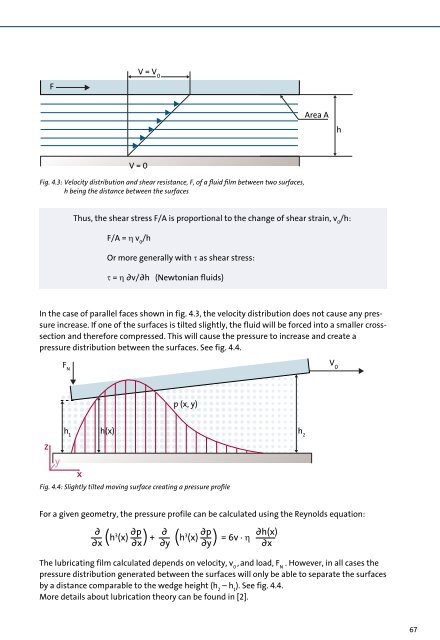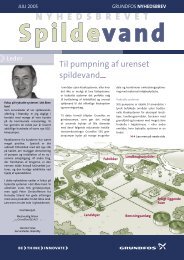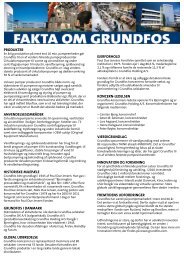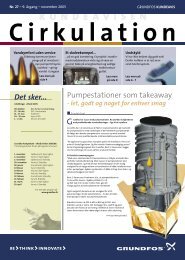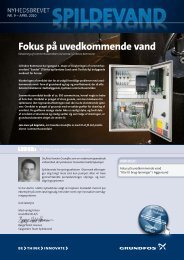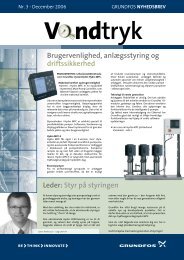Mechanical shaft seals for pumps - Grundfos
Mechanical shaft seals for pumps - Grundfos
Mechanical shaft seals for pumps - Grundfos
Create successful ePaper yourself
Turn your PDF publications into a flip-book with our unique Google optimized e-Paper software.
z<br />
F<br />
V = V 0<br />
V = 0<br />
Thus, the shear stress F/A is proportional to the change of shear strain, v 0 /h:<br />
F/A = h v 0 /h<br />
∂<br />
∂x(h 3 (x) ) + (h = 6v . η<br />
3 (x) )<br />
∂p ∂ ∂p<br />
∂h(x)<br />
Or more generally with t as shear stress:<br />
∂x ∂y ∂y<br />
∂x<br />
Area A<br />
h<br />
Area A<br />
In the case of parallel faces shown in fig. 4.3, the velocity distribution does not cause any pressure<br />
increase. If one of the surfaces is tilted slightly, the fluid will be <strong>for</strong>ced into a smaller cross-<br />
V = V<br />
section and there<strong>for</strong>e compressed. This 0<br />
F will cause the pressure to increase and V create a<br />
N<br />
0<br />
pressure F distribution between the surfaces. See fig. 4.4.<br />
y<br />
z<br />
h 1<br />
F<br />
x<br />
h(x)<br />
V = V 0<br />
Fig. 4.3: Velocity distribution and shear resistance, F, of a fluid film between two surfaces,<br />
h being the distance between V = the 0 surfaces<br />
y<br />
F N<br />
h 1<br />
x<br />
∂ t = h ∂v/∂h (Newtonian fluids)<br />
∂x(h 3 ∂p ∂<br />
(x) ) + = 6v . η<br />
∂x ∂y (h3 ∂p<br />
(x)<br />
∂y)<br />
h(x)<br />
V = 0<br />
p (x, y)<br />
p (x, y)<br />
Fig. 4.4: Slightly tilted moving surface creating a pressure profile<br />
∂h(x)<br />
∂x<br />
For a given geometry, the pressure profile can be calculated using the Reynolds equation:<br />
The lubricating film calculated depends on velocity, v 0 , and load, F N . However, in all cases the<br />
pressure distribution generated between the surfaces will only be able to separate the surfaces<br />
by a distance comparable to the wedge height (h 2 – h 1 ). See fig. 4.4.<br />
More details about lubrication theory can be found in [2].<br />
F N<br />
∂<br />
∂x(h 3 ∂p ∂<br />
(x) ) + = 6v . η<br />
∂x ∂y (h3 ∂p<br />
(x)<br />
∂y)<br />
∂h(x)<br />
∂x<br />
h 2<br />
h 2<br />
V 0<br />
h<br />
Area A<br />
V 0<br />
h<br />
67


